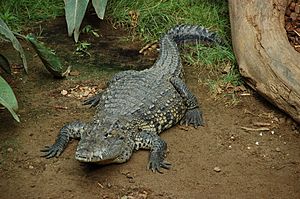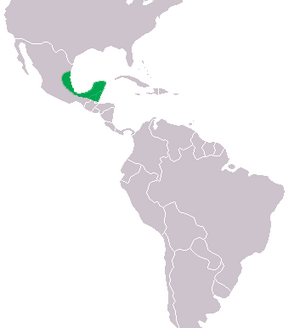Morelet's crocodile facts for kids
Quick facts for kids Morelet's crocodileTemporal range: Upper Pleistocene – recent
|
|
|---|---|
 |
|
| Conservation status | |
| Scientific classification | |
| Genus: |
Crocodylus
|
| Species: |
moreletii
|
 |
|
| Range of Crocodylus moreletii | |
The Morelet's crocodile (Crocodylus moreletii) is also known as the Mexican crocodile. It is a type of crocodile that lives only in freshwater areas. You can find it in the Atlantic regions of Mexico, Belize, and Guatemala. This crocodile usually grows to about 3 metres (9.8 ft) long. It is not considered an critically endangered species right now.
Contents
About Morelet's Crocodiles
Morelet's crocodiles are medium-sized reptiles. They have a broad snout and a dark, grayish-brown color. Their bodies often have dark spots and bands. Young crocodiles are usually lighter in color. These crocodiles are very good at hiding in their environment.
They are named after the French naturalist Pierre Morelet. He discovered this species in Mexico in 1850.
Where Morelet's Crocodiles Live
Morelet's crocodiles prefer freshwater habitats. They live in swamps, marshes, and large rivers. You can also find them in lakes and lagoons. Sometimes, they are seen in brackish water, which is a mix of fresh and salt water. This usually happens in coastal areas. They like places with lots of plants to hide in.
Their main home is in Central America. This includes the countries of Mexico, Belize, and Guatemala. They are an important part of the wetland ecosystems there.
What Morelet's Crocodiles Eat
Morelet's crocodiles are carnivores, meaning they eat meat. They are skilled hunters. They mostly eat fish, birds, and small mammals. They also eat other reptiles and amphibians. Young crocodiles eat smaller prey like insects and snails.
They are ambush predators. This means they wait quietly for their prey to come close. Then, they quickly attack. They usually hunt at night.
Life Cycle and Reproduction
Morelet's crocodiles reproduce during the dry season. This is usually from April to June. The female crocodile builds a nest. She uses mounds of dirt and plants. These nests are often near water.
She lays between 20 and 45 eggs. The eggs hatch after about 80 days. Both parents often guard the nest. They protect the eggs from predators. Once the babies hatch, the mother may carry them to the water. Young crocodiles stay with their mother for a while. This helps them stay safe.
Conservation Status
For a long time, Morelet's crocodiles were in danger. People hunted them for their skin. Their skin was used to make leather products. This caused their numbers to drop a lot.
Today, hunting them is mostly illegal. Their numbers have increased. The International Union for Conservation of Nature (IUCN) lists them as "Least Concern." This means they are not currently at high risk of extinction.
However, they still face some threats. Their habitats are being lost. This happens because of human development. Pollution also harms their homes. Conservation efforts are still important to protect them.
Images for kids
-
at Lago Cobá, Quintana Roo, Mexico
-
Baby Morelet's crocodiles at the Cotswold Wildlife Park, England
See also
 In Spanish: Cocodrilo de pantano para niños
In Spanish: Cocodrilo de pantano para niños






